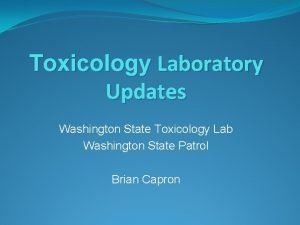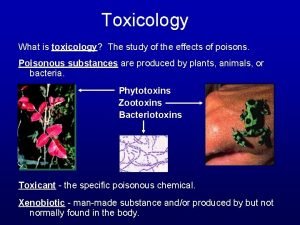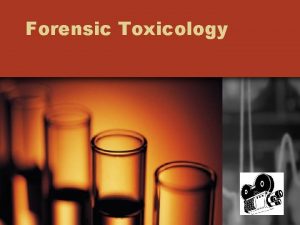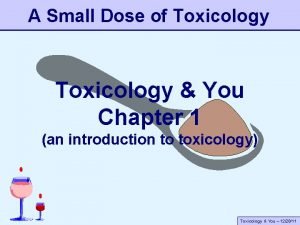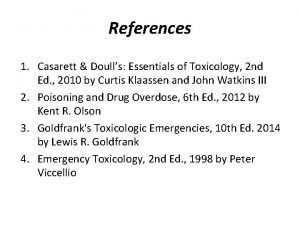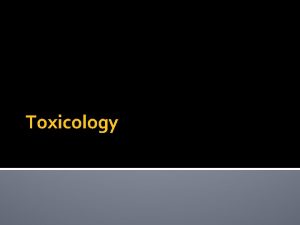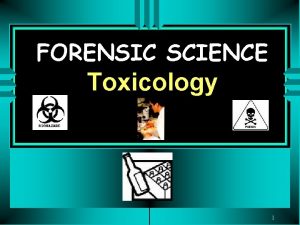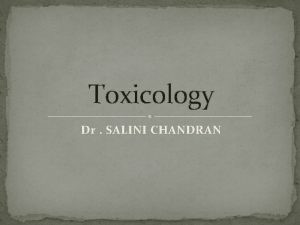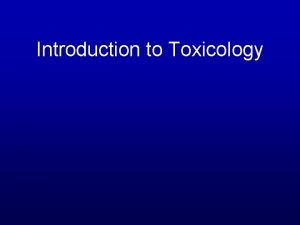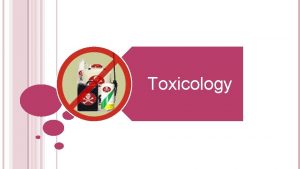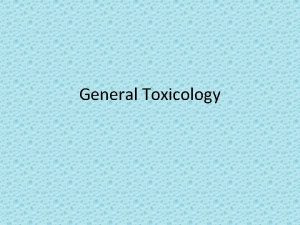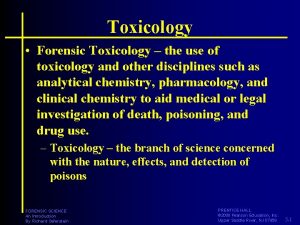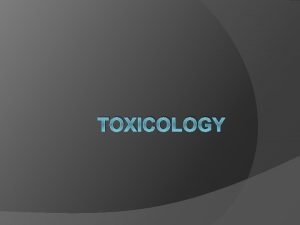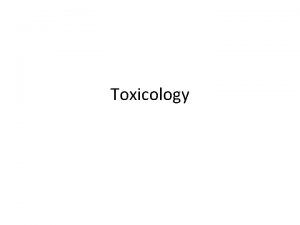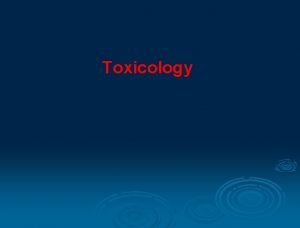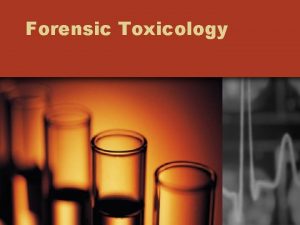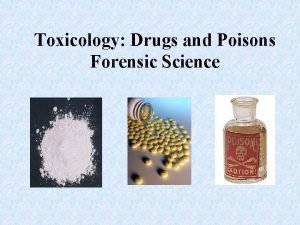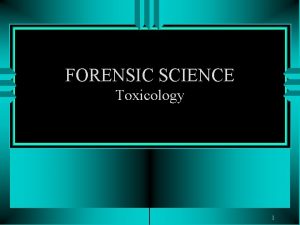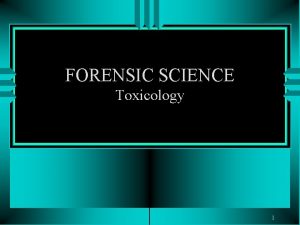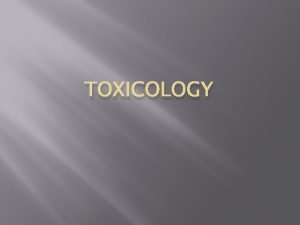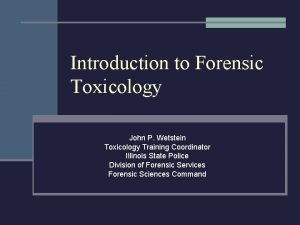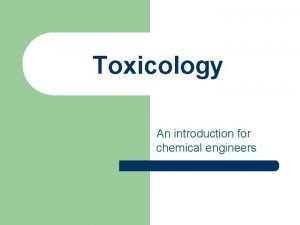TOXICOLOGY What is Toxicology Toxicology is the science


















































- Slides: 50

TOXICOLOGY

What is Toxicology? Toxicology is the science that studies the origin, nature, and properties of various poisons and/or drugs in body fluids, tissues and organs. Categories of toxicology include: Environmental --- air, water, soil n Consumer --- foods, cosmetics, drugs n Medical --- illness and injury n Clinical --- affect on the body n Forensic --- contribution to crime n

Forensic Toxicologist n n A forensic toxicologist uses the application of toxicology for the purpose of solving criminal cases. They are generally concerned with three main categories: 1. Detection of poisons and drugs in body fluids, tissues or organs. (spectrophotometry) 2. Testing for alcohol in urine or blood samples. chromatography, breathalyzers) 3. Identification of narcotics such as cocaine. layer chromatography, color testing) (gas (thin-

The first category - Poisons

DEFINITION OF POISON n n A poison is any agent capable of producing harm in a living organism. All substances are poisons; there is none which is not a poison. The right dose differentiates a poison from a remedy. n Paracelsus (1493 -1541)

CATEGORIES OF POISONS n n n Medicinal Agricultural Environmental/Industrial Natural Household Warfare

FORMS AND TYPES OF POISONS Poisons may be found in the form of: n Liquids – Ex. Gasoline n Solids – Ex. Pills n Sprays – Ex. Spray Cleaners n Invisible/Gas – Ex. Carbon Monoxide Poisons are distinguished as poisons, venoms or toxins. However, the term poison is generally used to describe the entire group.

Poison, Venom or Toxin ? n n A poison is a substance that is harmful when it is consumed or touched. Examples of poisons are neurotoxins on the skin and feathers of the hooded pitohui. http: //www. travelchannel. com/video /the-toxic-pitohui-bird-12041

Poison, Venom or Toxin? n Venom is a poison that is injected under the skin. All venom comes from animals.

Poison, Venom or Toxin? n n Toxins are poisonous substances produced by living cells or organisms. Ex: Botulinum

How is someone poisoned? n n Poisons may enter the body as a single massive dose or accumulate over time. A poison may be ingested, injected or inhaled. c. ROCUS

What is a Lethal Dose? n LD 50—refers to the dose of a substance that kills half the test population, usually within four hours. n It is expressed in milligrams of substance per kilogram of body weight.

Toxicity Classes LD 50 (rat, oral) Correlation to Ingestion by 150 lb Adult Human Toxicity <1 mg/kg a taste to a drop extremely 1 -50 mg/kg to a teaspoon highly 50 -500 mg/kg to an ounce moderately 500 -5000 mg/kg to a pint slightly 5 -15 g/kg to a quart practically nontoxic Over 15 g/kg more than 1 quart relatively harmless

RESULTS OF EXPOSURE LEVELS n Acute- death in less than 24 hours n Sub-Acute- death in one month or less n Sub-Chronic- death in 1 -3 months n Chronic- death in 3 months or never from the poison

THE CRIME OF POISON n Called the “coward’s weapon” n First choice of female poisoners n There are no witnesses n There is no sign of violence

Clues of a Poisoning n n n Different poisonings will have different effects on the body. The Medical Examiner will look for irritated tissues, characteristic odors and Mees lines which are single transverse white bands on nails. Analysis of body fluids are used to confirm the poisoning.

POISONERS IN HISTORY Egyptians (3000 BCE) n administered the penalty of the peach Sumerians (2500 BCE) n worshipped Gula, goddess of poison Hebrews (1000 BCE) § used poisoned arrows

POISONERS IN HISTORY n n n India (600 -100 BCE) n Added poison to food Mithridates (100 BCE – Prince of Persia) n Practiced on self n Created an antidote Greeks n “intoxicated” used to describe poisoning n Socrates poisoned with hemlock the 1 st case of capital punishment

POISONERS IN HISTORY n Romans n Agrippina wife of Claudius n Locusta the personal poisoner of Nero n 770 Roman females convicted as poisoners n Banned growth of Wolfsbane n 1 st law for homicide with poison

POISONERS IN HISTORY n n n 1419 - “Council of Ten” – Venice’s “City Counsel” would put out poisoning contracts on political enemies Italian schools for poisoners were popular In the 1570’s, 30, 000 in Paris used poison illegally 1776 George Washington was served poison peas 1800’s food tasters came into being

POISONERS IN HISTORY n n Louis XIV - priests warned of epidemic so he created poison task force 1900’s life insurance industry caused an increase in poisonings n Arsenic - used as inheritance powder n 1851 Arsenic Act

Orfila Mathieu Orfila n known as the father of forensic toxicology n 1814 published book called “Traite des Poisons” which described the study of the nature of poisons.

THE MOST COMMON TYPES OF POISONS ARE ACIDS AND BASES Acids There are many different kinds of acids, both harmful (strong) and harmless (weak). Most all have the same symptoms of creating burns, mostly around the mouth, lips and eyes when ingested.

STRONG ACIDS n n n Hydrochloric Acid- is used to clean bricks and metals as well as digesting food. Sulfuric Acid- mainly used in manufacturing paints, plastics, and fertilizers. Nitric Acid- is used in removing tarnish and making explosives.

WEAK ACIDS Carbonic Acid- known for carbonating beverages. Boric Acid- used in washing the eyes. Phosphoric Acid- used to make fertilizers and detergents. Acetic Acid- used to make cellulose acetate for fibers and films. Citric Acid- used in making soft drinks.

BASES Bases are substances that have a p. H scale between 7 and 14. Some examples include products such as lye, potash and hydroxides. Symptoms of a base poisoning are similar to acid in creating burns around the mouth, lips and eyes.

Poisonous or Not? n n n Often, a very common substance becomes poisonous due to the amount ingested, injected or inhaled. The LD 50 is the lethal amount. The following examples are by no means all of the possible poisons, venoms or toxins.

ALCOHOL AS A POISON n A Blood Alcohol Content (BAC) of. 40 is the average LD 50 for alcohol. n Legal limit in Georgia for someone driving is. 08 n Symptoms: vomiting, passed out, difficult to awaken and slow, shallow breathing. n Death from drowning in vomit or falling asleep and never awakening

AMATOXIN n n n Poisonous component of mushrooms Vomiting and profuse watery diarrhea followed by liver damage and finally the kidneys stop functioning One mushroom is lethal

ANTHRAX n Potential agent for biological warfare n Spore forming bacteria n Symptoms within 7 days n Rare in humans, but common in animals

ANTIFREEZE n Ethylene Glycol n A few tablespoons lethal for animals n Sweet taste, odorless, colorless n Forms crystals in the kidneys

ARSENIC n n n heavy metal and can be found in minerals in the ground used as a pesticide and herbicide. can create severe unexplained diarrhea, nausea and abdominal pain. It may produce a garlic breath odor.

Result of Arsenic Poisoning

CARBON MONOXIDE § Carbon monoxide is a colorless, tasteless, odorless gas created by the incomplete combustion of a fossil fuel. § Usually, poor maintenance or damage of an appliance in a poorly ventilated area is the main cause of CO poison § Exposure to CO causes headaches, nausea, convulsions, and ultimately death. § CO poisoning turns the skin bright cherry pink



CYANIDE Cyanide kills very quickly. Victims will have red skin. Potassium cyanide that was leaked into the water causes great damage to the ecology. Potassium cyanide smells like bitter almonds.

FOOD POISONING § E. coli, botulism and salmonella are three of the main culprits in food poisoning. § They can cause great abdominal pain, vomiting and even death. § Symptoms occur within 2 -6 hours.

HEMLOCK § Greatest amount of toxin in the roots. § May be mistaken for wild carrots § Acute sweating followed by paralysis. § Socrates execution

INSECTS § Many insects contain poisons or venom. § A person needs to receive immediate medical attention if bitten or stung. These include: Scorpion Tick Brown recluse spider

NICOTINE Nicotine is usually inhaled through cigars and cigarettes and affects the lungs, heart and brain. Poisoning can lead to dizziness, nausea, seizures, and coma.

PLANTS Several plants are known for their poisons A few favorites include: Poison Oak Poison Sumac “Leaves of three, let them be” Poison Ivy

RICIN n n Found in castor beans Prevents cells from making proteins Poison of bioterrorism 1 mg is lethal http: //www. youtube. com/ watch? v=cfh. Zu. Et. EEhg http: //www. youtube. com/ watch? v=r. ZO 5 Lf 8 w. D_c

SNAKES Several snakes are poisonous in the Southeast including rattlesnakes, copperheads, cottonmouths/water moccasins, and coral snakes. Immediate medical attention is needed if bitten.

STRYCHNINE § The berries of this plant contains the majority of the poison § Ingesting just a few seeds can cause death. § Causes a person to have convulsions and a darkening of the face and neck.

THALLIUM n n Mimics potassium in the body Builds over time to cause death Banned in U. S. since 1984 Cancer, hair loss and numb extremities

Polonium - 210 n n Because polonium emits only alpha particles, it can be safely carried in glass vials and will not set off radiation detectors at airports. Once ingested, it is hard to detect, because all the radiation remains in the body. n A lethal dose could be as little as a few milligrams. n http: //www. youtube. com/watch? v=WXo. Ymnx 0 K 5 I

WATER Extreme consumption of water in a short period of time n Results in electrolyte imbalance n Associated with long distance runners, and ecstasy use at raves n Symptoms similar to dehydration http: //www. youtube. com/watch? v=ENUs. Nx EZX 3 Q n

POISONINGS: ACCIDENTAL AND CRIMINAL n In North America, approximately two million cases of poisonings are voluntarily reported each year. “If all those buried in our cemeteries who were poisoned could raise their hands, we would probably be shocked by the numbers. ” —John Harris Trestrail, “Criminal Poisoning

Federal Regulatory Agencies that deal with Toxicological Issues n Food and Drug Administration (FDA) n Environmental Protection Agency (EPA) n Consumer Product Safety Commission n Department of Transportation (DOT) n Occupational Safety and Health Administration (OSHA)
 Why is science my favourite subject
Why is science my favourite subject Sự nuôi và dạy con của hổ
Sự nuôi và dạy con của hổ điện thế nghỉ
điện thế nghỉ Các châu lục và đại dương trên thế giới
Các châu lục và đại dương trên thế giới Dạng đột biến một nhiễm là
Dạng đột biến một nhiễm là Nguyên nhân của sự mỏi cơ sinh 8
Nguyên nhân của sự mỏi cơ sinh 8 Bổ thể
Bổ thể độ dài liên kết
độ dài liên kết 101012 bằng
101012 bằng Thiếu nhi thế giới liên hoan
Thiếu nhi thế giới liên hoan Tia chieu sa te
Tia chieu sa te Chúa sống lại
Chúa sống lại Một số thể thơ truyền thống
Một số thể thơ truyền thống Sơ đồ cơ thể người
Sơ đồ cơ thể người Số nguyên tố là gì
Số nguyên tố là gì Công thức tiính động năng
Công thức tiính động năng đặc điểm cơ thể của người tối cổ
đặc điểm cơ thể của người tối cổ Tỉ lệ cơ thể trẻ em
Tỉ lệ cơ thể trẻ em Các châu lục và đại dương trên thế giới
Các châu lục và đại dương trên thế giới ưu thế lai là gì
ưu thế lai là gì Thẻ vin
Thẻ vin Các môn thể thao bắt đầu bằng tiếng bóng
Các môn thể thao bắt đầu bằng tiếng bóng Tư thế ngồi viết
Tư thế ngồi viết Cái miệng nó xinh thế chỉ nói điều hay thôi
Cái miệng nó xinh thế chỉ nói điều hay thôi Hát kết hợp bộ gõ cơ thể
Hát kết hợp bộ gõ cơ thể Từ ngữ thể hiện lòng nhân hậu
Từ ngữ thể hiện lòng nhân hậu Trời xanh đây là của chúng ta thể thơ
Trời xanh đây là của chúng ta thể thơ Tư thế ngồi viết
Tư thế ngồi viết Gấu đi như thế nào
Gấu đi như thế nào V. c c
V. c c Thể thơ truyền thống
Thể thơ truyền thống Khi nào hổ mẹ dạy hổ con săn mồi
Khi nào hổ mẹ dạy hổ con săn mồi đại từ thay thế
đại từ thay thế Thế nào là hệ số cao nhất
Thế nào là hệ số cao nhất Diễn thế sinh thái là
Diễn thế sinh thái là Vẽ hình chiếu vuông góc của vật thể sau
Vẽ hình chiếu vuông góc của vật thể sau Ng-html
Ng-html Thế nào là mạng điện lắp đặt kiểu nổi
Thế nào là mạng điện lắp đặt kiểu nổi Mật thư tọa độ 5x5
Mật thư tọa độ 5x5 Lời thề hippocrates
Lời thề hippocrates Glasgow thang điểm
Glasgow thang điểm Vẽ hình chiếu đứng bằng cạnh của vật thể
Vẽ hình chiếu đứng bằng cạnh của vật thể Quá trình desamine hóa có thể tạo ra
Quá trình desamine hóa có thể tạo ra Definition of environmental toxicology
Definition of environmental toxicology Food safety and toxicology
Food safety and toxicology Which is more toxic
Which is more toxic Wsp toxicology lab
Wsp toxicology lab Toxicology effects
Toxicology effects What is forensic toxicology definition
What is forensic toxicology definition A small dose of toxicology
A small dose of toxicology Toxicology effects
Toxicology effects














































